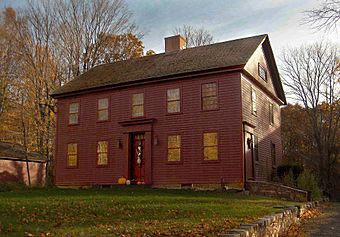Luman Andrews House facts for kids
Quick facts for kids |
|
|
Luman Andrews House
|
|
 |
|
| Location | 469 Andrews St., Southington, Connecticut |
|---|---|
| Area | 1.8 acres (0.73 ha) |
| Built | 1745 |
| Architectural style | Greek Revival, Colonial, New England Colonial |
| MPS | Colonial Houses of Southington TR |
| NRHP reference No. | 88003095 |
| Added to NRHP | January 19, 1989 |
The Luman Andrews House is a very old and special home in Southington, Connecticut. It is located at 469 Andrews Street. This house was built way back in 1745, making it one of the oldest buildings in Southington.
What makes this house extra interesting is that its land was also used to make a special kind of cement long ago. This 1.8-acre (0.73 ha) property was added to the National Register of Historic Places in 1989. This means it is recognized as an important historical site.
What Does the Luman Andrews House Look Like?
The Luman Andrews House stands in a quiet, country part of Southington. It is a two-and-a-half-story building made of wood. The roof slopes down on the sides, and it has a chimney in the middle. The outside walls are covered with wooden boards called clapboards.
The front of the house has five window sections, called bays. The main door is in the center. Above the door, there is a small window with four glass panes. The doorway is decorated in a style called Greek Revival. This style uses tall, flat columns and a fancy top part. The sides of the house also show Greek Revival changes, with triangular shapes at the top.
The Secret of the Blue Limestone
On the property, you can still find parts of an old lime kiln. A lime kiln was like a big oven used to heat rocks. There was also a quarry on the land. A quarry is a place where rocks are dug out of the ground.
In the 1830s and 1840s, a special type of rock was found here. This rock was used to make Portland cement. This was very important because before this, most cement had to be brought to the United States from England.
Who Built and Owned This Historic Home?
The Luman Andrews House was first built in 1745 by a person named Nathaniel Messenger. Back then, it only had four window sections. Later, in 1795, Eunice Judd Root bought the house. She added the fifth window section, making it bigger.
In 1818, Luman Andrews bought the house. His father was a hero in the American Revolutionary War. Luman Andrews made an amazing discovery on his new property. He found blue limestone. This blue limestone was a key ingredient for making Portland cement.
Luman Andrews started a quarry and a kiln to make cement right there. This business was very successful until about 1860. The Greek Revival style changes you see on the house today were made while Luman Andrews owned it. The house stayed in the Andrews family until 1873, when it was sold to new owners.



